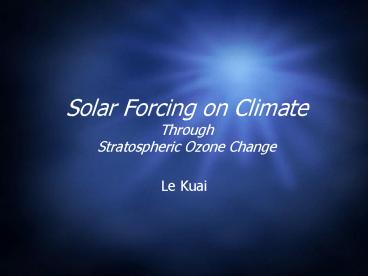Solar Forcing on Climate Through Stratospheric Ozone Change - PowerPoint PPT Presentation
1 / 20
Title:
Solar Forcing on Climate Through Stratospheric Ozone Change
Description:
Polar vortex intensification (PVI) The circumpolar wind and polar cooling ... To investigate the role of QBO on vortex intensification and breakdown ... – PowerPoint PPT presentation
Number of Views:103
Avg rating:3.0/5.0
Title: Solar Forcing on Climate Through Stratospheric Ozone Change
1
Solar Forcing on ClimateThrough Stratospheric
Ozone Change
- Le Kuai
2
Objectives
- Quantify the solar influence on the climate
change. - - UV radiation changes 3.4
- - through ozone in stratosphere
- Explore the effect of the solar variability
- -on ozone, radiative heating rates
- -influences on climate dynamics and
- stratosphere-troposphere coupling
3
The Statement of Problem
4
Stratosphere
- Dynamical interannual variability
- 1) the annular modes (NAM, SAM)
- 2) QBO in the tropics
- 3) Solar cycle
5
Solar Cycle vs Annular Modes
- Solar UV variations
- temperature and ozone changes in stratosphere
- Propagate downwards to troposphere
- NAM tends to its negative phase at solar min
- SAM
- - extend to upper stratosphere at solar max
- - confined in tropo-sphere at solar min
6
Quasi-biennial Oscillation (QBO)
- Driven by small scale wave and tropical
circulation. - An alternation of anomalous eastward and westward
equatorial stratospheric winds
7
QBO and solar cycle
- Mayr et al. (2006)
- the QBO serves as an amplifier of the solar
- influence in the lower stratosphere.
- Hines(1974)
- solar variability could influence the
- interaction between planetary waves and
- zonal mean flow.
- This interaction is affected by solar variability
and dependent on the QBO phase. - 50-hpa geopotential height
- solar minima low during the w QBO phase
- high during the e
QBO phase - solar maxima opposite relationship
8
Ozone in stratosphere
- EOF First mode 45, PC 28 months
- EOF Second mode 34, PC 11-yr
- - 10 DU about 4 of mean column ozone
9
Previous achievement
- Ruzmaikin and Feynman (2002)
- relation between NAM and QBO
- Ruzmaikin et al. (2004)
- patterns of climate change at the
Maunder Minimum - Limpasuvan et al. (2005)
- PVI and SSW
- Camp et al. (2003)
- QBO and solar cycles as leading
modes in ozone. - Ruzmaikin et al. (2005)
- QBO signature in the Brewer-Dobson
circulation. - Jiang et al. (2005)
- modeling of QBO in column O3 in the
tropics
10
- Winter stratoshperic polar vortex weaken
- Sudden Stratospheric Warming (SSW)
- temperature
- westerly zonal mean wind
- Planetary waves propagating from the troposphere
(Andrew et al., 1987, )
11
- Polar vortex intensification (PVI)
- The circumpolar wind and polar cooling
- Induced by the gradual radiative cooling under
reduced wave activity
12
Proposal
13
Approach
- Observation
- Idealized models
- 1-D photochemical model (Allen et al.
1981) - 2-D model with simplified chemistry but
more - realistic transport (Yung and Miller
1997 Morgan - et al. 2004)
- interactive 2-D model THIN AIR (K. K.
Tung) - Whole Atmospheric Community Climate
Model - (WACCM)
- Coupled models
14
Task 1 Solar variability in UV, O3 and radiative
heating
- Ozone layer is the link of sun and climate
- Ozone concentration depends on temperature
- Temperature varies according to the UV changes
and dynamical processes (27-day range) - Ozone connects the solar UV changes to heating
rates and dynamics.
15
Problem and Solution
1. Ozone
- Observed Ozone Variation 4 at 1-3 hPa
- Modeled Ozone Variation 2 at 5 hPa
- Model/observation comparison
- - using the SORCE solar UV flux data
- - the MLS O3 over 27-day solar
- rotation cycle.
16
2. Heating Rate
- 3 DU increase in the ozone column
- - 0.3 C warming in the stratosphere
- - 10 m increase in geopotential height.
- (Camp, et al. 2003)
- - will be confirmed by MODTRAN (Moderate
resolution Transmittance) code - (Berk et al. 1998)
- To improve the heating rate algorithms used in
the interactive codes.
17
Task 2 Impact of Ozone changes in GCM
- Without resolved gravity waves, most models
(WACCM) do not exhibit an accurate QBO. - Ozone variability underestimate.
- Large difference between model and observations.
- New physical parameterizations are included.
(travaling gravity waves, a longwave radiation
and merged shortwave radiation parameterization)
18
Extended Investigation and Perceived Impact
- To investigate the role of QBO on vortex
intensification and breakdown - To exam possible influences of the ENSO and
Pacific-North American (PNA) patterns on
evolution of the polar vortex forced by solar UV - The simple dynamical model (SDM) could be used to
study QBO effects and solar variability. - The EMD method will be applied to analysis of
data on the 11-year time scale
19
Plan for proposal study and paper review
- R-L Shia introduce 2-D model, especially the
THIN AIR. - Xun talk about the ozone (QBO, interannual
variability, N/SAM, ) - Fai the paper about solar cycle
- Le Kuai the paper about QBO, interaction of QBO
and solar cycle
20
Thank you!Questions

